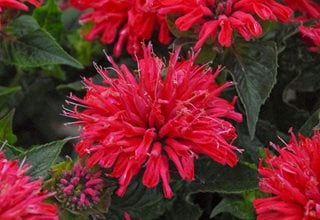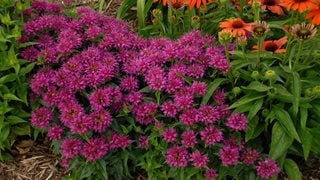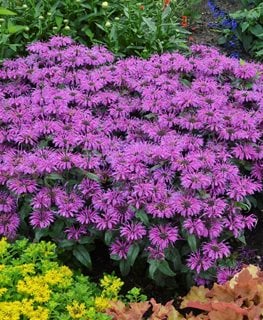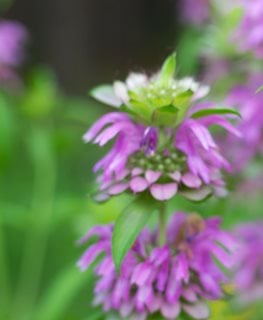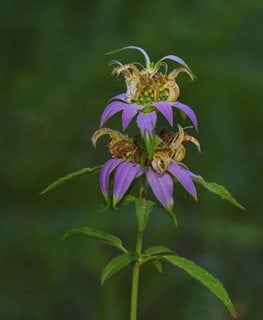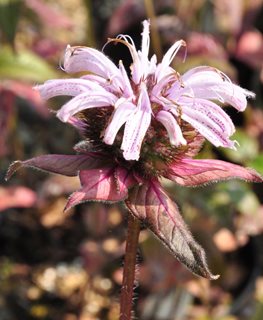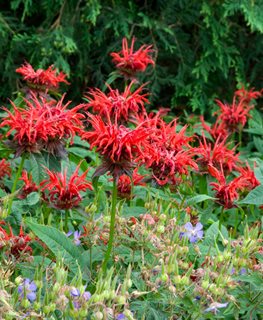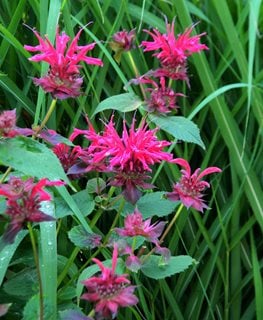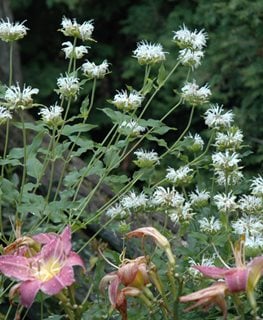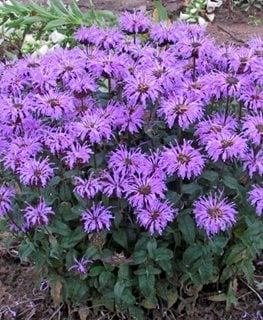GROWING BEE BALM
Bring color and wildlife into your yard with this reliable favoriteGardening for nature has become increasingly popular in recent years. One of the best plants for attracting and supporting wildlife is bee balm, which blooms throughout the summer. Also known as horsemint, Oswego tea, and bergamot, the flower nectar provides sustenance for pollinating insects such as bees, butterflies, moths; as well as hummingbirds, while the seed heads are a food source for songbirds during fall and winter.
Garden uses for this old-fashioned favorite are varied: in a mixed border, cutting garden, along pathways and in containers. Newer varieties have been bred for disease-resistance and smaller stature more suitable to urban yards.
On this page: Basics | Planting | Care | Choosing the Right Bee Balm | Pictures | Landscaping Tips
THE BASICS
Zones:
3-9
Height/Spread:
Varieties from 10 inches to 4 feet tall, and 8 inches to 3 feet wide.
Exposure:
Full sun to partial shade. Plants bloom best and are less susceptible to disease when planted in full sun.
Bloom time:
Late spring to fall
Color and characteristics:
Sage-like flowers that are reminiscent of fireworks produce arching tubular petals in terminal whorls, often with colored bracts. Blooms occur on long square stems—sometimes layered on top of each other—in shades of red, pink, lavender, white, or purple. Aromatic oval to lance-shaped leaves are green or blue-green.
Toxicity:
Bee balm is not harmful to children or pets. The scented flowers and foliage have a wide range of medicinal and herbal qualities and can be used for tea, potpourri, garnishes, and rubs. The crushed leaves act as a natural mosquito repellent. See more safe plants: 20 Common Plants Safe for Cats & Dogs.
Background:
A member of the mint family, bee balm is native to woodland and prairie regions of North America, comprising 15 species of annuals and clump-forming rhizomatous perennials. Bee balm was historically used by indigenous tribes and early settlers for medicinal and culinary purposes. The pungent leaves are reminiscent of sage and can be brewed for tea or added to salads and other dishes, while flowers serve as a colorful garnish.
PLANTING TIPS
When to plant:
Sow seeds in spring, and plant transplants during cooler months of spring or fall.
Where to plant:
In a sunny site with fertile, well-draining soil that will stay evenly moist.
How to plant:
Loosen soil and amend with compost. Remove plant from container and gently tease out roots if potbound. Dig a hole slightly larger than the root ball and place so the top of the crown is level with the soil surface. Fill in the hole, gently tamp down soil around the base and water well. Space 1-1/2 to 2 feet apart, depending on the variety, to ensure good air circulation.
For seeds, sow directly outdoors after all danger of frost is past. Cover with 1/4 inch of fine soil and keep moist until seedlings emerge, 22 to 30 days. Thin to 18 inches apart when seedlings are two inches tall.
CARE AND MAINTENANCE
Pruning, deadheading, and maintenance:
To create a bushier plant, pinch stem tips as new growth emerges in early spring. Remove spent flowers to encourage rebloom. Perennial bee balms are vigorous growers, so regular division every 2 to 3 years is necessary to keep them in check. After the first hard frost, clean up leaf debris to help prevent disease in the next growing season. Leave dormant plants so that birds can forage the seed heads during fall and winter. Cut back dead flower stalks in late winter or early spring to a few inches above the ground.
Soil:
Bee balm is tolerant of different soils, but prefers humus-rich soil that drains well. Soil pH should be neutral or slightly acidic.
Amendments & fertilizer:
Work an all-purpose fertilizer into the soil around the base of plants in spring according to package instructions. Mulch with organic matter such as shredded leaves to suppress weeds and retain moisture.
Watering:
Bee balm can tolerate some drought, but prefers moist soil. Water regularly once or twice a week during hot spells. Avoid overhead watering to reduce mildew and fungal disease.
Diseases and pests:
When planted in ideal conditions, bee balm is relatively carefree. The biggest problem is powdery mildew that develops on flower buds and foliage. The gray powdery film is not fatal, but can stress plants and cause leaf drop. Too much shade, lack of air circulation, or high humidity can increase mildew and other fungal diseases such as rust and leaf spot. To combat mildew, removed affected leaves and dispose in the garbage rather than compost pile to prevent spread of disease. Apply an organic remedy according to instructions. Poor soil drainage can result in root rot. Insect problems include stalk borers, spider mites, whiteflies, slugs, and thrips.
Deer resistance:
Because of bee balm’s pungent fragrance, deer will usually leave it alone, though extreme conditions can result in deer grazing on plants they wouldn’t otherwise.
HOW TO CHOOSE THE RIGHT BEE BALM
With different types and sizes to choose from, here are some tips to consider:
For beds and borders:
Larger varieties can be planted midway in a mixed border in combination with other perennials, shrubs, and trees. Smaller forms can be sited toward the front of a bed or border.
For cutting gardens:
Plant in a raised bed in combination with other summer-blooming cut flowers.
For edible gardens:
Place near a kitchen garden to attract insect pollinators for increased food production.
For containers:
Plant smaller varieties in containers by themselves, or in combination with other low-maintenance plants with similar needs. See more perfect pollinator combinations like “Pollinator House” (pictured) that include bee balm.
For wildlife garden:
Naturalize varieties that are native to your region in a meadow or dedicated area along with other natives that will support local wildlife.
Love perennials? Learn more, along with timely planting advice, garden design inspiration, tips and more in our weekly newsletter.
BEE BALM PICTURES
Bee balm alternatives:
In areas with hot, humid summers such as the Southeastern U.S. where mildew is problematic, substitute with other long-blooming summer flowers such as penstemon or salvia.
LANDSCAPING TIPS
There are many ways to incorporate bee balm into your landscape. Here’s how:
- Mass taller forms in a mixed border in combination with other long-blooming summer perennials such as Shasta daisies, veronica, perennial sunflower and tall garden phlox for cottage-style appeal.
- Combine a dwarf specimen in a container with other summer-blooming perennials or annuals for months of continuous color.
- Plant a taller red form near your home’s kitchen or living room window to enjoy hummingbirds up close. (Also see: The 24 Best Plants to Attract Hummingbirds)
- Edge pathways and borders with dwarf types for a cheerful accent.
- Create a cutting garden in a raised bed and combine bee balm with other summer blooming cut flowers such as dahlias, cosmos, sunflowers and zinnias for months of colorful bouquets.
- Plant a clump of a bright red or purple variety at the end of a pathway as a compelling focal point to draw the eye through the landscape.
- In a larger landscape, repeat a taller form in the same color throughout a border to unify the space.
- Naturalize wildflower types with other native plants and provide shelter, food, water and nesting areas for a complete habitat to support local wildlife.
RELATED:
Perennials You’ll Love
20 Full-Sun Perennials
10 Ways to Start Building a Garden for Wildlife
Flowers for a Bee-Friendly Garden
20+ Cottage Garden Plants
